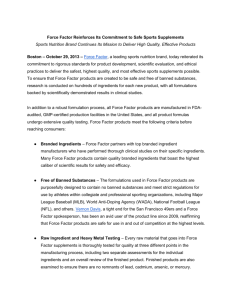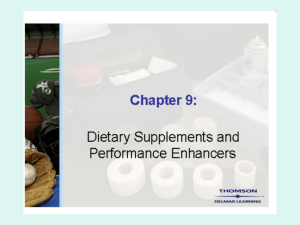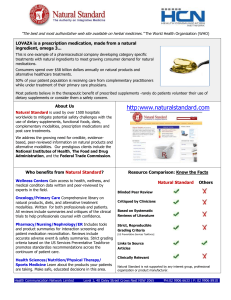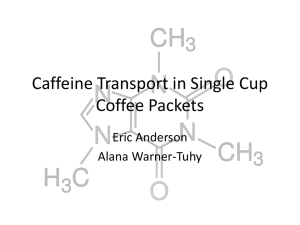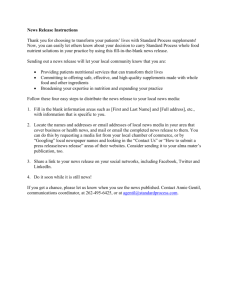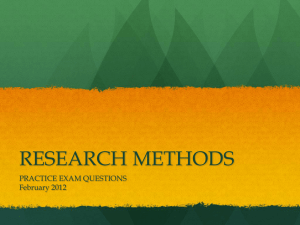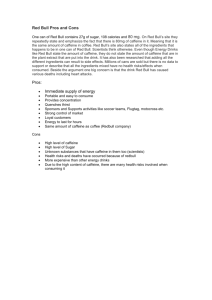guidelines for use of supplements
advertisement
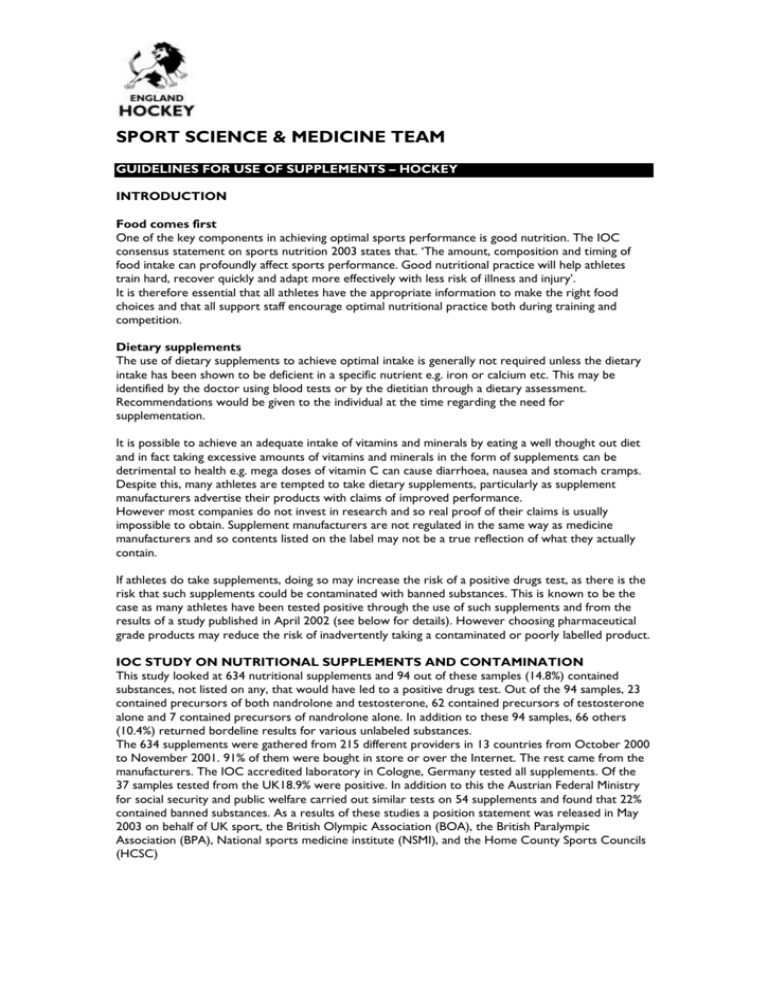
SPORT SCIENCE & MEDICINE TEAM GUIDELINES FOR USE OF SUPPLEMENTS – HOCKEY INTRODUCTION Food comes first One of the key components in achieving optimal sports performance is good nutrition. The IOC consensus statement on sports nutrition 2003 states that. ‘The amount, composition and timing of food intake can profoundly affect sports performance. Good nutritional practice will help athletes train hard, recover quickly and adapt more effectively with less risk of illness and injury’. It is therefore essential that all athletes have the appropriate information to make the right food choices and that all support staff encourage optimal nutritional practice both during training and competition. Dietary supplements The use of dietary supplements to achieve optimal intake is generally not required unless the dietary intake has been shown to be deficient in a specific nutrient e.g. iron or calcium etc. This may be identified by the doctor using blood tests or by the dietitian through a dietary assessment. Recommendations would be given to the individual at the time regarding the need for supplementation. It is possible to achieve an adequate intake of vitamins and minerals by eating a well thought out diet and in fact taking excessive amounts of vitamins and minerals in the form of supplements can be detrimental to health e.g. mega doses of vitamin C can cause diarrhoea, nausea and stomach cramps. Despite this, many athletes are tempted to take dietary supplements, particularly as supplement manufacturers advertise their products with claims of improved performance. However most companies do not invest in research and so real proof of their claims is usually impossible to obtain. Supplement manufacturers are not regulated in the same way as medicine manufacturers and so contents listed on the label may not be a true reflection of what they actually contain. If athletes do take supplements, doing so may increase the risk of a positive drugs test, as there is the risk that such supplements could be contaminated with banned substances. This is known to be the case as many athletes have been tested positive through the use of such supplements and from the results of a study published in April 2002 (see below for details). However choosing pharmaceutical grade products may reduce the risk of inadvertently taking a contaminated or poorly labelled product. IOC STUDY ON NUTRITIONAL SUPPLEMENTS AND CONTAMINATION This study looked at 634 nutritional supplements and 94 out of these samples (14.8%) contained substances, not listed on any, that would have led to a positive drugs test. Out of the 94 samples, 23 contained precursors of both nandrolone and testosterone, 62 contained precursors of testosterone alone and 7 contained precursors of nandrolone alone. In addition to these 94 samples, 66 others (10.4%) returned bordeline results for various unlabeled substances. The 634 supplements were gathered from 215 different providers in 13 countries from October 2000 to November 2001. 91% of them were bought in store or over the Internet. The rest came from the manufacturers. The IOC accredited laboratory in Cologne, Germany tested all supplements. Of the 37 samples tested from the UK18.9% were positive. In addition to this the Austrian Federal Ministry for social security and public welfare carried out similar tests on 54 supplements and found that 22% contained banned substances. As a results of these studies a position statement was released in May 2003 on behalf of UK sport, the British Olympic Association (BOA), the British Paralympic Association (BPA), National sports medicine institute (NSMI), and the Home County Sports Councils (HCSC) SPORT SCIENCE & MEDICINE TEAM SUPPLEMENTS POSITION STATEMENT ‘UK athletes are advised to be extremely cautious about the use of any supplements. No guarantees can be given that any particular supplement, including vitamins and minerals, ergogenic aids, and herbal remedies, is free from prohibited substances as these products are not licensed and are not subject to the same strict manufacturing and labelling requirements as licensed medicines. Antidoping rules are based on the principle of strict liability and therefore, supplements are taken at an athlete’s risk and personal responsibility’ This statement reflects the current state of the supplements market and all hockey players should be aware of the risks involved in taking supplements and should be discouraged from doing so. If a specific need for a supplement is identified, this should be discussed with the doctor and dietitian. SUPPLEMENT TESTING To get supplements tested for purity by a reliable laboratory is very expensive and does not provide a guarantee to the safety of the supplements. It would not be sufficient to just test one bottle of supplements to see if it was safe. Each batch would have to be tested to ensure it had not been contaminated. This is not currently an option available, so there is no way of telling whether a supplement is safe or not. HERBAL AND NUTRITIONAL SUPPLEMENTS Some of the commonly available and popular supplements are listed below. Remember these products are not licensed and are not subject to strict regulatory and licensing requirements regarding labelling of constituent substances and manufacturing that licensed pharmaceutical products are. They may therefore contain prohibited substances VITAMINS AND MINERALS Vitamins and minerals may contain prohibited substances and so are not advised. However athletes determined to take them despite the warnings should ensure they only buy reputable brands, check the label and seek advise first from their sports dietitian or doctor. GINSENG There are many varieties of ginseng and it is claimed that some forms can affect the CNS having a stimulant like effect reducing fatigue as well as claims to improve concentration, immune function and slow the aging process. There is no conclusive evidence that ginseng has any benefit to sporting performance. There have been instances were products named ginseng have contained prohibited substances such as ephedrine, anabolic steroids etc MA HUANG (CHINESE EPHEDRA) Ma Huang is a Chinese herb extract that contains several ephedra alkaloids including the banned substance ephedrine. It is a common ingredient in many dietary supplements that are promoted to increase energy or assist with weight loss. Many reports have documented adverse effects in people taking ephedra such as high blood pressure, insomnia, tachycardia, nervousness, tremors seizures, cardiac arrest, stroke and death. A potentially dangerous substance to be avoided. CREATINE MONOHYDRATE Creatine supplementation is thought to be beneficial to competitors who compete in sports requiring short burst of maximal effort (e.g. weight lifting or sprinting) or repeated bursts of short, high intensity activity. It is not know how long creatine can safely be taken for, and there are several potential side effects. The European commission scientific committee on food has concluded that high doses of creatine should be avoided and that consumption of lower doses (up to 3g.day) are unlikely to pose any risk to health. However, some creatine supplements have been found to contain banned substances and so the same advice should be adhered to as other supplements discussed. SPORT SCIENCE & MEDICINE TEAM AMINO ACIDS Amino Acids make up the structure of protein and are popular supplements with body builders. It is possible to eat sufficient protein through dietary means to enhance muscle mass development without the use of such supplements. There is no evidence that the use of Amino acids will enhance performance and the risk of contamination with banned substances is the same as with other supplements CAFFEINE Caffeine was removed from the banned substance list in January 2004. It does however remain on the monitoring programme and will be monitored to detect patterns of misuse in sport. It may be added to the prohibited list again if it is found to be misused. o Caffeine when taken 1-3 hours before exercise can improve performance in both endurance and high intensity exercise. o The likely mechanism is via the central nervous system (CNS) and effects include altered perception of fatigue and effort. It may also improve alertness, reaction time and attention span. Caffeine may also have direct effect on the muscle. Caffeine may increase the mobilisation and utilisation of fatty acids, leading to a sparing of muscle glycogen. This however this is thought to be the less likely mechanism to explain its effect on sports performance. o Benefits occur at modest levels - 1-3mg caffeine/kg body weight, when taken before and/or during exercise. This is a lower dose than has been quoted in the past (6-9mg/kg has been used) and is a result of recent research (Cox 2002). There is not a dose response relationship so increasing dose will not provide further benefit. o The effect of caffeine differs between individuals. Some individuals do not respond and others may experience negative side effects such as tremors, increased heart rate and headaches. These side effects are more common at higher doses i.e. 6-9mg caffeine /kg o Other side effects caused by taking too large a dose include nausea, irritability, diarrhoea, insomnia, trembling and nervousness. More severe side effects include peptic ulceration, delirious seizures, coma and superventricular and ventricular arrhythmias. A condition known as known as caffeinism has been described by Greden, characterised by symptoms including anxiety, mood changes, sleep disturbances and psychological changes. People with such symptoms may experience withdrawal symptoms. Excessive doses of caffeine, up to 10g can be lethal, causing seizures, tachycardia, or ventricular dysrrythmias. o Taking caffeine 5-10mins before exercise may have an effect on performance as it enters the blood stream quickly. However if caffeine is taken 1 hour before exercise it will have time to reach max concentration in the blood and so the effects may be greater. o High doses – above 300mg will have a diuretic effect, and may affect hydration status. Hence it is important to keep the intake below this. o Taking 1-3mg/kg about 1 hour before training would be sufficient to have a performance enhancing effect. E.g. if an athlete weighs 70kg a dose of 70 – 210mg caffeine would be sufficient. Taking caffeine on a regular basis can be habit forming and so if athletes choose to take it should use it sensibly. SPORT SCIENCE & MEDICINE TEAM Average caffeine content of drinks Beverage Average caffeine content per 200ml serving Tea from tea bags Tea from loose tea Instant tea Decaffeinated tea Instant coffee Filter/percolated Grande size starbucks may contain 600mg caffeine Decaffeinated Chocolate drinks Cola drinks – standard and sugar free ‘Energy’drinks Coca cola Diet coke Red bull Pro plus 65mg 20mg 37mg <4mg 58mg 104mg 2mg 1-8mg 7-43mg 58mg 32mg per 330ml can 43mg per 330ml can 80mg per 250ml can 50mg per tablet (no more than 2 tablets per hour – as stated on instructions) Please see separate sheet on caffeine for more detailed information PSEUDOEPHEDRINE Pseudoephedrine has been removed from the prohibited list of substances, but ephedrine is still prohibited. Pseudoephedrine like caffeine, remains on the monitoring program. Pseudoephedrine is a central nervous system stimulant and therefore is potentially open to misuse. o Pseudoephedrine is available in over the counter medications and is principally used as a decongestant in preparations such as cold remedies. It exerts is effect through stimulation of α –1 adrenoreceptors in vascular smooth muscle, leading to vasoconstriction and a decrease in mucus secretion. o It also causes stimulant effects to the central nervous system and so may increase alertness, decrease fatigue levels and increase competitiveness and aggression. o Possible side effects of these over the counter remedies include headache, tacycardia, dizziness, hypertension, irritability, sleep disturbance and anxiety. o They may also make it difficult for an athlete to cool down, particularly after exercising for long periods of time. At high dose they could cause mania or psychosis. Severe effects could also include cerebral haemorrhage and stroke. o It must be remembered that ephedrine is still a prohibited substance so ingredient lists should be carefully checked and advice sort from the Doctor, or anti doping officer if athletes are unsure. SPORT SCIENCE & MEDICINE TEAM References Armstrong L E. Caffeine, body fluid-electrolyte balance, and exercise performance. Int. J Sports Nutr. and Exerc. Met. 12, 189-206, 2002 Bent, S et al. The relative safety of ephedra compared with other herbal products, Ann Intern Med. March 18, 2003 Bahrke M, S, Morgan W P. Evaluation of the ergogenic properties of ginseng. Sports Med. Feb: 29(2): 113 –133, 2000. Web sites: www.uksport.gov.uk www.olympics.org.uk www.eis2win.co.uk www.ais.org.au Drugs in sport. The pressure to perform. BMA 2002 Hargreaves M, Hawley JA, (eds). Physiological Bases of Sports Performance, Mc Graw Hill, Sydney, 2003: 183-253. Chapter 9: Burke, L M. Sports Supplements and Sports Foods Cox G R, et al. Effect of different protocols of caffeine intake on metabolism and endurance performance. J Appl. Physiol. 93: 990-999, 2002 Graham T E, Spriet L L. Metabolic, catecholamine, and exercise performance responses to various doses of caffeine. J Appl. Physiol. 78:867-874, 1995 Greden J F, Anxiety or caffeinism: A diagnostic dilemma. Am J psychiatry 1974; 131:1089-92 Kovacs E M R, et al. Effect of caffeinated drinks on substrate metabolism, caffeine excretion, and performance. J. Appl. Physiol. 85(2): 709-715, 1998 Maughan R J, Griffin J. Caffeine ingestion and fluid balance: a review. J Hum Nutr Dietet, 16 pp 411 – 420, 2003 The manual of dietetic practice, 3rd Edition. Blackwell science, 2001
